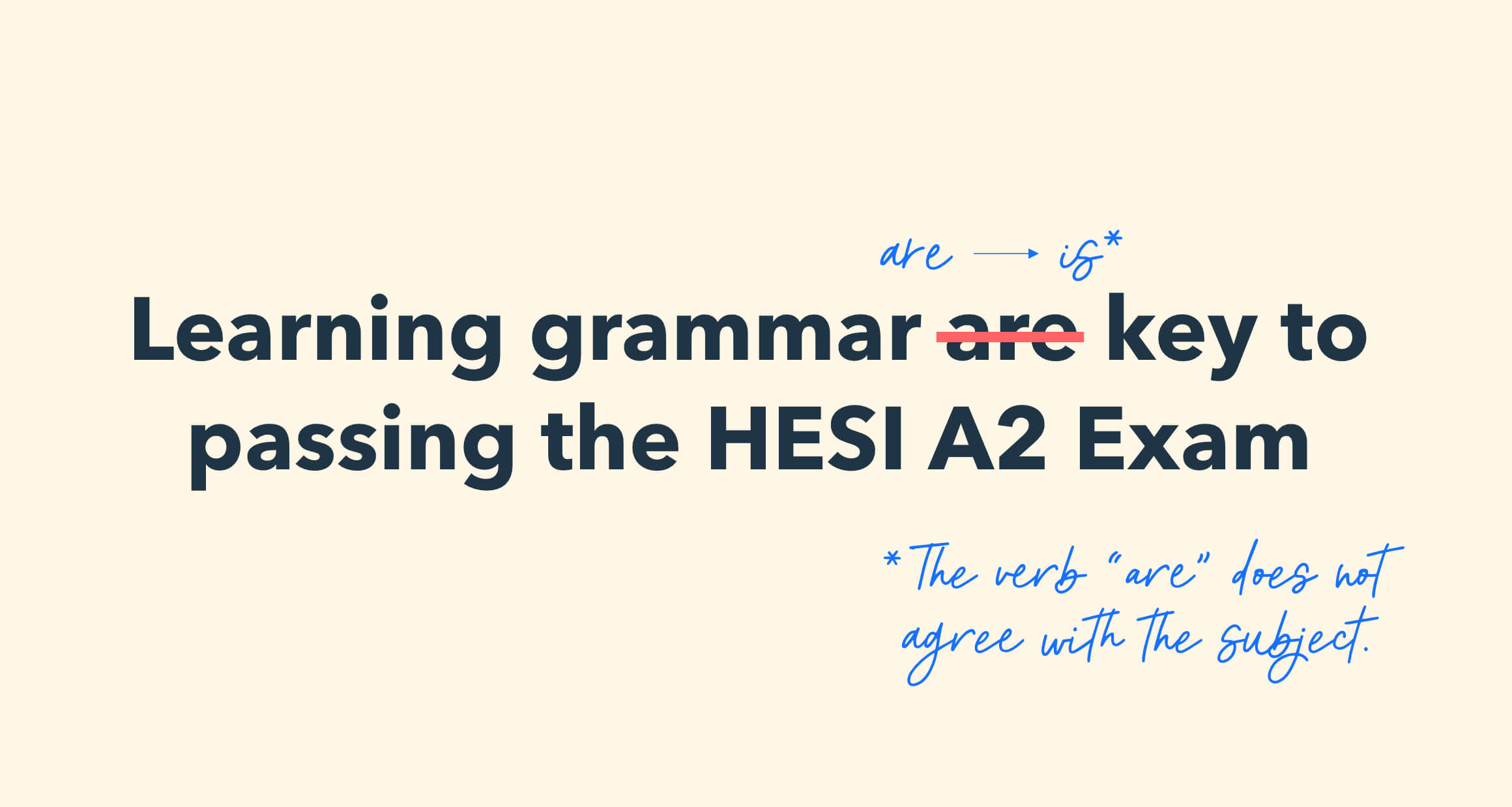How Will Knowing Effective Study Tools Affect Your HESI A2 Grammar Score?
Does the question above make sense? Can you understand the difference and meaning of effect and affect and how it was used in the question above? Knowing (or not knowing) the difference will absolutely affect your HESI A2 grammar score! The HESI A2 Grammar section will cover all eight parts of speech, including adjectives and adverbs. We will go over the top ten grammatical mistakes made in the HESI. Knowing the difference between these troublesome word pairs will prepare you to ace the grammar section of the HESI A2 exam.

Affect vs Effect
Affect means to change or influence something and is almost always used as a verb.
- In general, influenza most drastically affects infants, young children, and very old adults.
Affect can be used as a noun, however, affect as a noun is solely for psychology & psychiatry applications.
- This patient displays inhibited affect; she needs further evaluation.
Effect is used to describe the results of a change and is almost always a noun.
- The citizens of Puerto Rico are still suffering from the catastrophic effects of the 2017 hurricane season.
Effect can be used as a verb when something is “brought about.” In other words, effect as a verb produces a result.
- The boss sternly advised her employee to effect change by Friday.
Here is a mnemonic device to help you remember when to use each:
Passing the HESI A2 will affect your life; you’ll feel the effects when nursing schools beg you to enroll!
Among vs Between
Among is used when describing a relationship of more than two things or people.
- Let’s hand these fliers out among the crowd. (Here, the relationship is the crowd, which consists of multiple people.)
- The friendship I was talking about is among Annie, Brianna, and Cate. (Here, the relationship consists of three people.)
Between is used when describing a relationship in regards two things or people.
- Go sit over there between those two girls. (Here, the relationship consists of two girls.)
- Between you and I, I don’t like the new science teacher. (Here the relationship consists of you and I.)
Amount vs Number
Amount is used when referring to things that cannot be counted. For example, trust and courage are things that cannot be counted.
- The amount of courage he displayed by jumping into the water was impressive. (Here, courage is being described. This makes amount the correct word for this sentence, as “courage” cannot be counted.)
Number is used to count nouns. It is used in reference to things that can be counted. For example, people and pencils are two things that can be counted.
- I only need a small number of candles to cover the cake. (Here, candles are being described. Since it is something that can be counted, number is used.)
Good vs Well
Good is used as an adjective.
- My teacher told me I did a good job with my homework. (Here, good is used as an adjective to describe the job.)
- He did not feel good after she broke up with him. (Here, good is used to describe emotional health.)
Well is most often used as an adverb. Well answers the question of “how?” and can sometimes be used as an adjective to describe physical health.
- My teacher told me I did my homework well. (Here, well is used as an adverb to explain how the homework was done.)
- Do you feel well? (Here, well is used as an adjective to describe physical health.)
Its vs It’s
Its is used for possessive applications.
- The gorilla brushed its own teeth. (Here, its without the apostrophe is used because it has a possessive meaning in the sentence.)
- I got a new wagon, and its color is bright red. (Here, its without the apostrophe is used because it has a possessive meaning in the sentence.)
It’s is a contraction and means “it is” or “it has.”
- It’s raining outside. (Here, it’s with the apostrophe is used because it means, “it is” in this sentence.)
- I know it’s been very busy for you at work. (Here, it’s with the apostrophe is used because it means, “it has” in this sentence.)
A good way to remember which one to use is to substitute it’s in a sentence for it is or it has. If the sentence still makes sense, then it’s is the correct form. If it does not make sense, use the other form.
Farther vs Further
Farther is used when referring to physical distance. It can be used as an adjective or an adverb.
- My school is farther from my house than the grocery store. (Here, farther is used because it is referring to a physically measurable distance.)
Further is used when referring to nonphysical distances or things that cannot be physically measured. It can be used as an adjective, adverb, or a verb.
- Do you have any further questions for me? (Here, further is used because it is referring to a nonphysical distance/amount.)
Then vs Than
Then has multiple definitions. “At that time,” “next,” “also,” “in addition,” “in that case,” “therefore,” and “as a consequence” are all definitions of then. It is most often used as an adverb, but it can be used as an adjective or a noun at times.
- Then, he jumped from the ledge and almost knocked me down. (Here, then means “at that time.”)
- If you have all your stuff, then you can leave. (Here, then means “in that case.”)
Than is a conjunction used only to compare things.
- I am taller than my brother. (Here, than is the correct word because it is comparing the height of two people.)
- That bully thinks he is better than me. (Here, than is the correct word because it is comparing two people.
Which vs That
Which is used to connect an unnecessary dependent clause to a sentence.
- Our house, which has three floors, is on Rutherford street. (Here, which is used because it connects the unnecessary clause, which has three floors, to the rest of the sentence. If this dependent clause was removed, the sentence would mean the same thing.)
That is used to connect a necessary clause to a sentence.
- Our house, that has three floors, is on Rutherford street. (Here, that is used because it connects a piece that is necessary to give the sentence full meaning. It can be assumed there are multiple houses and that identifies the specific house in mention.)
Fewer vs Less
Fewer is used when referencing things that can be counted, such as books, candles, or coins.
- You have fewer marbles than I do. (Here, fewer is used because marbles are something that can be counted.)
Less is used when referencing things that cannot be counted. It is also used with collective nouns and abstract nouns.
- I like him less than I like her. (Here, less is used because the concept of liking or disliking a person cannot be counted.)
Sentence Fragments & Complete Sentences
Sentence fragments are incomplete sentences. They contain a dependent clause but no independent clause. Often, sentence fragments lack a subject-verb relationship.
- As he colored. (Here, this sentence lacks an independent clause, the word “as” makes this a dependent clause.)
A complete sentence should include a subject and a verb, or an independent clause if it begins with a conjunction/adverb/preposition.
- I cleaned the kitchen as he colored. (Here, the dependent clause from the example above is combined with the independent clause, I cleaned the kitchen, to make a complete sentence.)
These topics are what HESI A2 calls “troublesome word pairs” and undoubtedly show up on the HESI A2 Grammar section.

